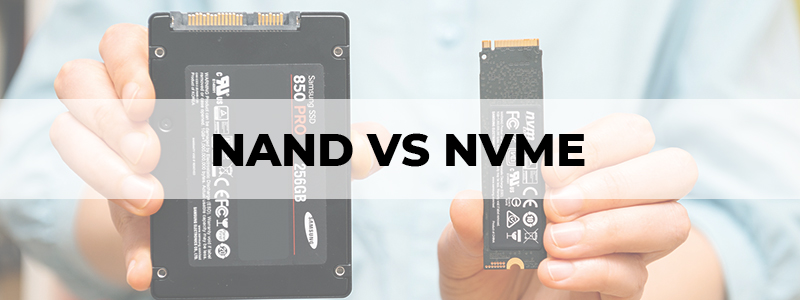
The growing need for data storage capacity and speed in industrial and commercial applications has resulted in an ever-increasing range of storage alternatives.
Keeping up with technological developments and deciding what works best in particular applications is a never-ending effort for engineers and OEMs. NAND vs NVMe is a topic that comes up frequently—what are these two technologies, and how do they compare?
NAND vs NVMe, it turns out, aren’t in competition with one another. Instead, when used together, they may provide data-intensive applications with lightning-fast read and write rates.
Here we look at NAND and NVMe and see if there is a comparison between the two.
What is NAND?
The most prevalent option of flash memory is NAND. It may be found in SSDs, USB flash drives, and SD cards, among other storage devices. NAND memory is non-volatile, which means it keeps its data even if the power is switched off.
NAND Flash is everywhere in our cellphones, modern TVs, and our home and office PCs and laptops. Outside, it may be found in a variety of devices, including traffic lights, digital advertising panels, passenger announcement systems, and displays.
NAND Flash is likely to be found in anything that has artificial intelligence (AI) and needs to store data. There are two types of NAND Flash: industrial and consumer.
Since there are substantial variations between industrial and consumer-grade NAND, it’s critical to examine how these differences affect reliability, durability, compliance, and total cost of ownership (TCO) before choosing the right NAND Flash for your application.
3D NAND
3D NAND is a new player on the NAND Flash scene. Despite the fact that the concept of 3D NAND is not new, it has only recently gained traction in the market.
It’s the most significant advancement in NAND since its conception in the 1980s, but getting 3D NAND to operate reliably has been a challenge. These obstacles have already been addressed, and 3D NAND will undoubtedly continue to be the NAND Flash of choice for many years to come.
This is referred to as V (vertical) NAND by certain manufacturers. 3D NAND is the layering of memory chips on top of one another. This NAND aims to help applications and devices function quicker and more effectively while also storing more data and using less energy.
Samsung, a household name and the world’s largest NAND Flash producer, with over 40% of the worldwide NAND market, was the first to introduce 3D NAND.
What is NVMe?
NVMe, a non-volatile memory express, is new storage access and file transfer protocol for flash and next-generation solid-state drives (SSDs). It provides the best bandwidth and response times for all sorts of corporate workloads.
Users demand quicker response times in both consumer and commercial apps today, even as the programmes themselves grow more complicated and resource-intensive.
The NVMe protocol allows users to access flash storage by a PCI Express (PCIe) bus, which can support tens of thousands of parallel command queues and is therefore much quicker than HDDs and traditional all-flash architectures, that are restricted to a single command queue to help deliver a high-bandwidth, low-latency user experience.
The NVMe standard allows non-volatile memory to be used in a variety of computer settings. It’s also future-proof, as it can be extended to operate with yet-to-be-developed persistent memory technologies.
NVMe a SATA Alternative
The transition from hard disc drives, or HDDs, to solid-state drives, or SSDs, was the first in the evolution of mechanical storage systems.
SSDs have the advantage over HDDs. They don’t have any moving components that might fail or slow them down, making them quicker and more dependable.
The SATA interface, or Serial ATA, became the most prevalent interface used alongside SSDs as they evolved. Advanced Host Controller Interface, or AHCI, is the mechanism that connects SATA to the CPU.
The issue with AHCI is that it was designed for HDD systems that include moving components. Latency is significant when SATA and AHCI are used together. Furthermore, the SATA transfer rate is restricted at a lower level than what today’s systems can handle.
The Non-Volatile Memory Express (NVMe) standard was created to bridge this gap. In order to achieve transfer speeds that are adequate for today’s SSD technology, NVMe employs PCI Express, or PCIe, rather than AHCI.
When compared to SATA, NVMe offers quicker input and output speeds, faster data access, and lower latency.
NAND vs NVMe isn’t the Main Question; Its NVMe vs SATA
SATA and NVMe operate with NAND flash memory, which is the most common flash memory used in SSDs.
Because NVMe was built mainly for SSDs, NAND that uses it performs quicker than SATA-based alternatives. On the other hand, SATA is still widely used and appreciated for its dependability and interoperability with a wide range of applications.
When evaluating flash storage alternatives, developers should evaluate a variety of variables, including cost and product availability.
